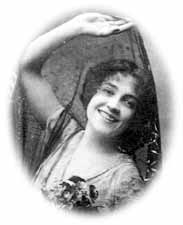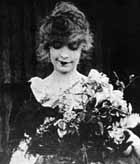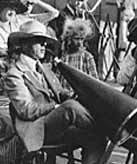4
|
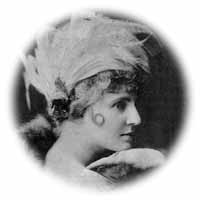
| Publicity photo of Florence Lawrence |
After spreading the story that she had been killed in a streetcar accident, Laemmle produced Florence Lawrence, now an "Imp Girl" (Imp was the popular name of his Independent Motion Picture Company), who would henceforth appear under her own name in his pictures. The independents were likewise more willing to move into the production of longer and feature-length films than the Trust companies, a move that dovetailed neatly with a fuller exploitation of the potential of stars in such films.
As Staiger notes, the rise of the movie star system is intricately bound to the prior existence of a star system in closely related media: "Whether the demand for stars came first from the consumers or was created by enterprising capitalists is immaterial in this case since the precedents in theater and vaudeville are so immediate" (Bordwell, Classical, 101). In this respect, probably the most important early event in emergence of the star system was the founding of Famous Players Film Company by an Hungarian Jewish immigrant, Adolph Zukor--based on his phenomenal success with the four-reeler he imported from France, Queen Elizabeth starring Sarah Bernhardt.
|
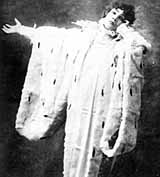
| Sarah Bernhardt in Queen Elizabeth |
The company's motto, "Famous Players in Famous Plays," perfectly summed up its strategy of appealing to middle-class audiences by featuring renown stage actors in feature-length "photoplays." Soon came James O'Neill (Eugene's father) in The Count of Monte Cristo and James K. Hackett in The Prisoner of Zenda. Two other immigrants, Jesse Lasky and Samuel Goldfish (later Goldwyn), quickly followed suit, founding the Jesse L. Lasky Feature Players company (a newcomer, Cecil B. De Mille, was their director), a company that merged with Zukor's in 1916, creating the second great organization of the post-Trust era.
In 1915, the government's three-year suit against the trust was decided in favor of the independents, but the latter group had already won its battle economically. For instance, the defection of D.W. Griffith, the leading stylistic innovator in the industry, from Biograph to the new Mutual in 1913, after rejecting earlier offers from independent producers, was a clearly a sign that the independents, with their riskier, more innovative management styles, were carrying the day. Within two years he would make The Birth of a Nation, probably the most influential motion picture ever made and certainly a film that could never have been made at Biograph. It was also a film that firmly fixed at least three "stars" in the public consciousness: Lillian Gish, Mae Marsh and Griffith himself.
It is perhaps tempting to see all this "trust-busting" as the triumph of enterprising immigrant entrepreneurs,5 entrepreneurs who perhaps identified at some level with the new stars they had created, over the conservative, essentially WASP-led (with a French admixture) forces of a trust that tried to monopolize the very apparatus of filmmaking. It is also quite short-sighted to do so. For instance, the very championing of individual players soon became a key part of a market strategy that would lead to that eight-company monopoly (Laemmle's company became Universal, Zukor's Paramount) that far exceeded in terms of rigid control, especially of actors' persona and freedom, anything the Edison-led trust ever envisioned. When, in the late 1930s, the government instituted a suit against this monopoly (a vertically integrated system of production, distribution and exhibition), it was attacking a trust that rigidly controlled 90% of film production and owned virtually all the prime theaters in the country.
page 2 of 9


Go to:
Introduction
Part One: The emergence of the star system
Part Two: The real, the "reel," and fan magazines
Part Three: The selling of stars
Part Four: The close-up and Alice Adams
Part Five: Cultural self-importance and A Star is Born
Part Six: Studio battlers--James Cagney and Bette Davis
Part Seven: The power of stars, the power of agents, and Jimmy Stewart
Wrap-up
Notes
Works Cited
Brian Gallagher is a professor of English and film at the City University of New York (LaGuardia).




